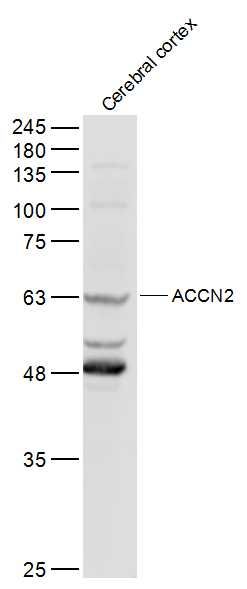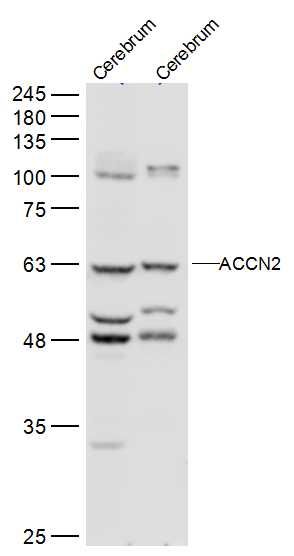产品中心
当前位置:首页>产品中心Anti-ACCN2
货号: bs-2586R 基本售价: 780.0 元 规格: 50ul
- 规格:50ul
- 价格:780.00元
- 规格:100ul
- 价格:1380.00元
- 规格:200ul
- 价格:2200.00元
产品信息
- 产品编号
- bs-2586R
- 英文名称
- ACCN2
- 中文名称
- 酸敏感离子通道1抗体
- 别 名
- ASIC1; Acid sensing ion channel 1; Acid sensing ion channel 1a protein; Acid sensing ion channel; Acid-sensing ion channel 1; AI843610; ASIC1_HUMAN; Acid-sensing ion channel 1; Amiloride-sensitive cation channel 2, neuronal; Brain sodium channel 2; BNaC2; BNAC2.
- 规格价格
- 50ul/780元购买 100ul/1380元购买 200ul/2200元购买 大包装/询价
- 说 明 书
- 50ul 100ul 200ul
- 研究领域
- 神经生物学
- 抗体来源
- Rabbit
- 克隆类型
- Polyclonal
- 交叉反应
- Human, Mouse, Rat, Chicken, Cow, Horse,
- 产品应用
- WB=1:500-2000 ELISA=1:500-1000 IHC-F=1:400-800 ICC=1:100-500 IF=1:100-500 (石蜡切片需做抗原修复)
not yet tested in other applications.
optimal dilutions/concentrations should be determined by the end user.
- 分 子 量
- 58kDa
- 细胞定位
- 细胞膜
- 性 状
- Lyophilized or Liquid
- 浓 度
- 1mg/ml
- 免 疫 原
- KLH conjugated synthetic peptide derived from human ASIC1:301-400/526 <Extracellular>
- 亚 型
- IgG
- 纯化方法
- affinity purified by Protein A
- 储 存 液
- 0.01M TBS(pH7.4) with 1% BSA, 0.03% Proclin300 and 50% Glycerol.
- 保存条件
- Store at -20 °C for one year. Avoid repeated freeze/thaw cycles. The lyophilized antibody is stable at room temperature for at least one month and for greater than a year when kept at -20°C. When reconstituted in sterile pH 7.4 0.01M PBS or diluent of antibody the antibody is stable for at least two weeks at 2-4 °C.
- PubMed
- PubMed
- 产品介绍
- background:
Cation channel with high affinity for sodium, which is gated by extracellular protons and inhibited by the diuretic amiloride. Also permeable for Ca(2+), Li(+) and K(+). Generates a biphasic current with a fast inactivating and a slow sustained phase. Mediates glutamate-independent Ca(2+) entry into neurons upon acidosis. This Ca(2+) overloading is toxic for cortical neurons and may be in part responsible for ischemic brain injury. Heteromeric channel assembly seems to modulate channel properties. Functions as a postsynaptic proton receptor that influences intracellular Ca(2+) concentration and calmodulin-dependent protein kinase II phosphorylation and thereby the density of dendritic spines. Modulates activity in the circuits underlying innate fear.
Function:
Cation channel with high affinity for sodium, which is gated by extracellular protons and inhibited by the diuretic amiloride. Also permeable for Ca(2+), Li(+) and K(+). Generates a biphasic current with a fast inactivating and a slow sustained phase. Mediates glutamate-independent Ca(2+) entry into neurons upon acidosis. This Ca(2+) overloading is toxic for cortical neurons and may be in part responsible for ischemic brain injury. Heteromeric channel assembly seems to modulate channel properties. Functions as a postsynaptic proton receptor that influences intracellular Ca(2+) concentration and calmodulin-dependent protein kinase II phosphorylation and thereby the density of dendritic spines. Modulates activity in the circuits underlying innate fear.
Subunit:
Homotrimer or heterotrimer with other ASIC proteins. Interacts with PRKCABP and ACCN1. Interacts with STOM.
Subcellular Location:
Cell membrane; Multi-pass membrane protein. Note=Localizes in synaptosomes at dendritic synapses of neurons. Colocalizes with DLG4.
Tissue Specificity:
Expressed in brain areas receiving strong excitatory corticofugal input. In hippocampus, expressed in the hilus of the dentate gyrus. In the cerebral cortex expressed in anterior and posterior cingulate cortex, sensory and motor cortices. In the sensory cortex strongest expression is detected in the whisker barrel field. In sensorimotor and cingulate cortex expression is elevated in layer III. Also expressed in basal ganglia, striatum, ventral pallidum, olfactory tubercle, and nucleus accumbens. Weakly expressed in thalamus with the exception of the habenula and the medial septal nuclei. In olfactory bulb, preferentially expressed in the glomerular layer, within glomeruli. Expressed in cerebellum in the molecular and granule cell layers. Strongly expressed in amygdala complex, particularly in the lateral and basolateral nuclei. Isoform 1 is more abundant in brain compared to isoform 2 (at protein level). Expressed in the nodose ganglion and dorsal root ganglion. Expressed in dendritic spine cells.
Post-translational modifications:
Phosphorylation by PKA regulates interaction with PRKCABP and subcellular location. Phosphorylation by PKC may regulate the channel.
Similarity:
Belongs to the amiloride-sensitive sodium channel (TC 1.A.6) family. ACCN2 subfamily.
SWISS:
P78348
Gene ID:
41
Database links:Entrez Gene: 41 Human
Entrez Gene: 11419 Mouse
Entrez Gene: 79123 Rat
Omim: 602866 Human
SwissProt: P78348 Human
SwissProt: Q6NXK8 Mouse
SwissProt: P55926 Rat
Unigene: 274361 Human
Unigene: 440107 Mouse
Unigene: 37385 Rat
Important Note:
This product as supplied is intended for research use only, not for use in human, therapeutic or diagnostic applications.
ASIC1也是ASICs一类胞外质子激活阳离子通道蛋白,主要分布于神经系统,参与神经生理生化及神经损伤与退变的很多生理功能。
- 产品图片
 Sample:
Sample:
Cerebral cortex (Mouse) Lysate at 40 ug
Primary: Anti-ACCN2 (bs-2586R) at 1/300 dilution
Secondary: IRDye800CW Goat Anti-Rabbit IgG at 1/20000 dilution
Predicted band size: 58 kD
Observed band size: 63 kD Sample:
Sample:
Cerebrum (Mouse) Lysate at 40 ug
Cerebrum (Rat) Lysate at 40 ug
Primary: Anti-ACCN2 (bs-2586R) at 1/500 dilution
Secondary: IRDye800CW Goat Anti-Rabbit IgG at 1/20000 dilution
Predicted band size: 58 kD
Observed band size: 63 kD

